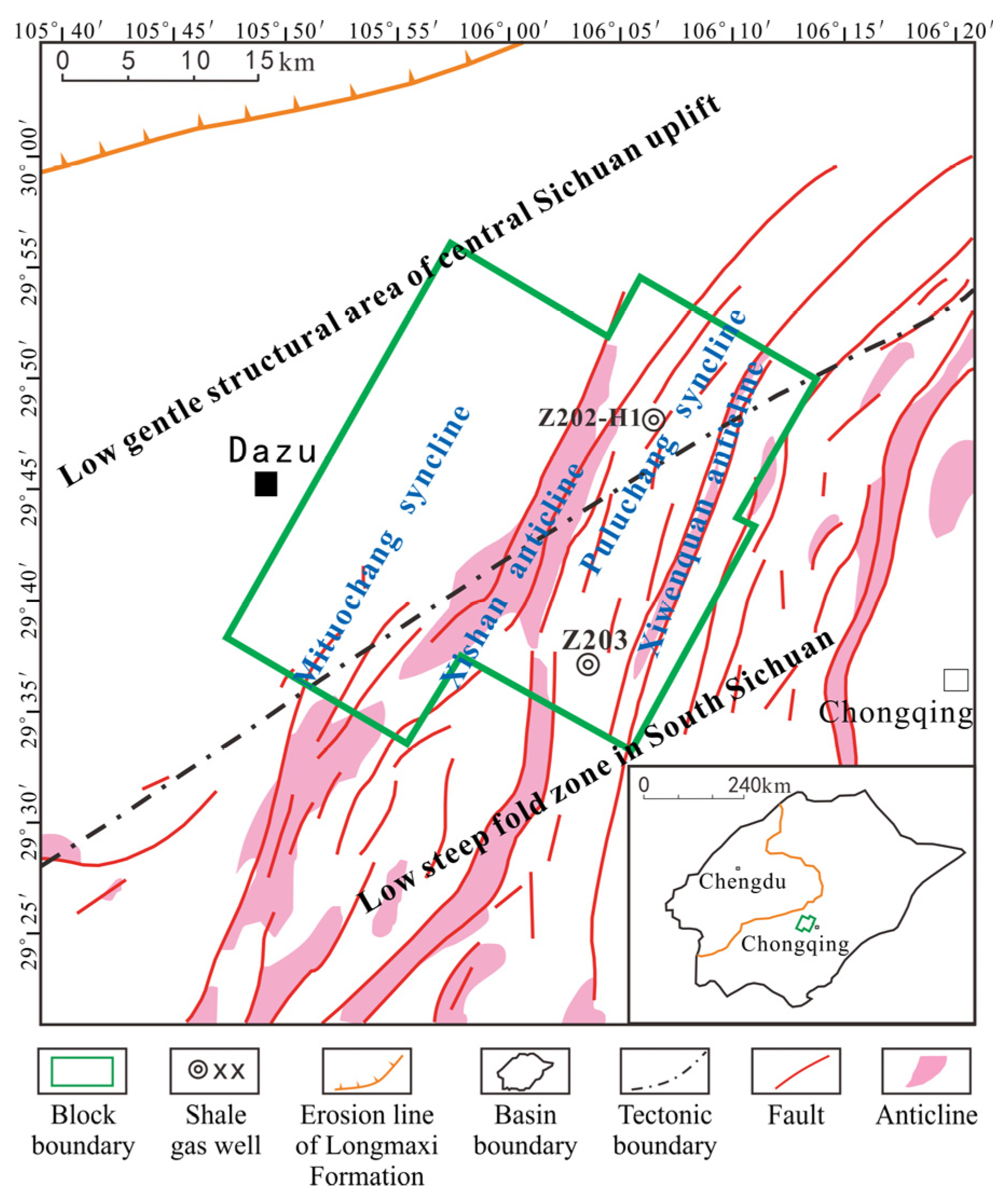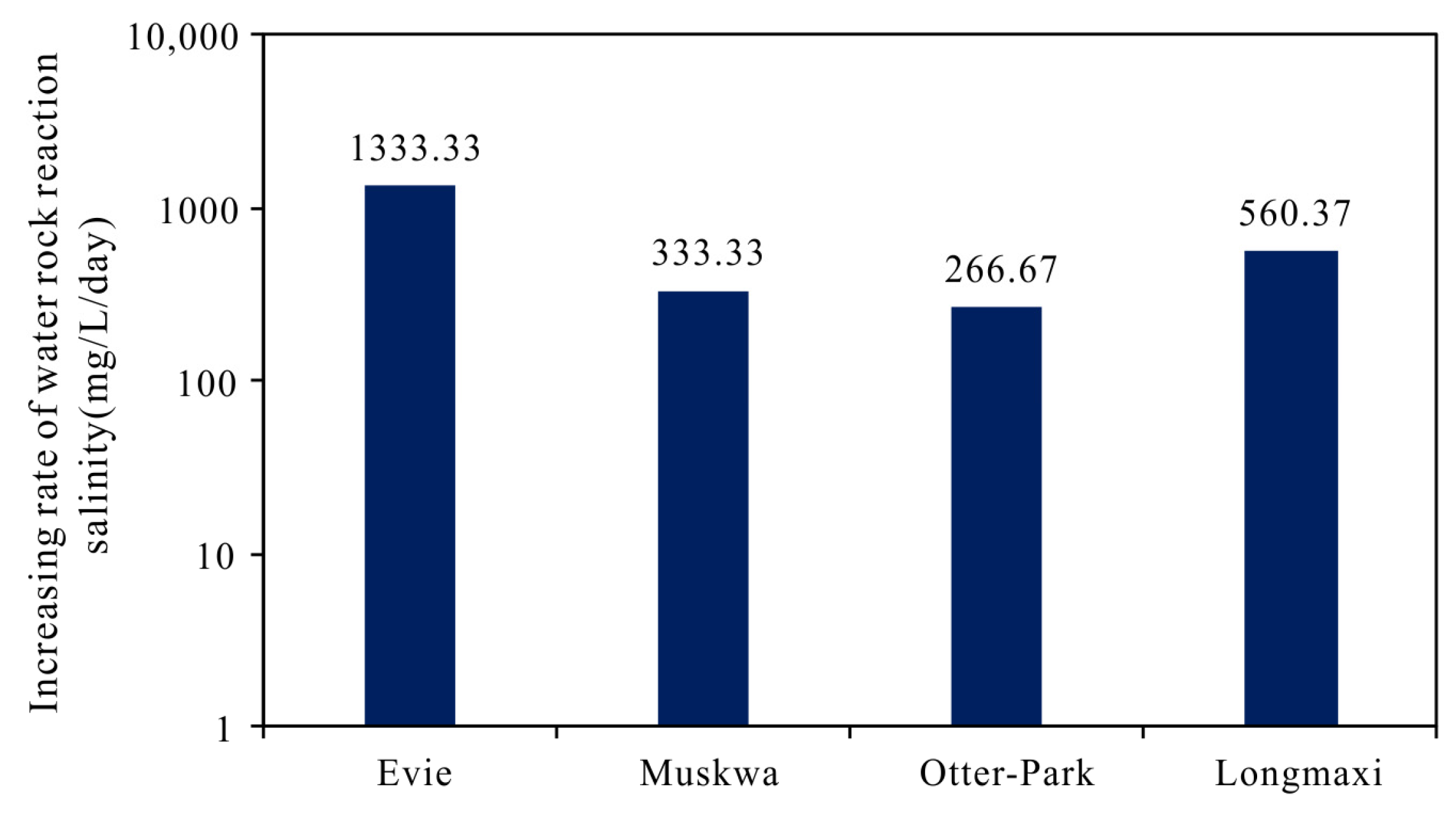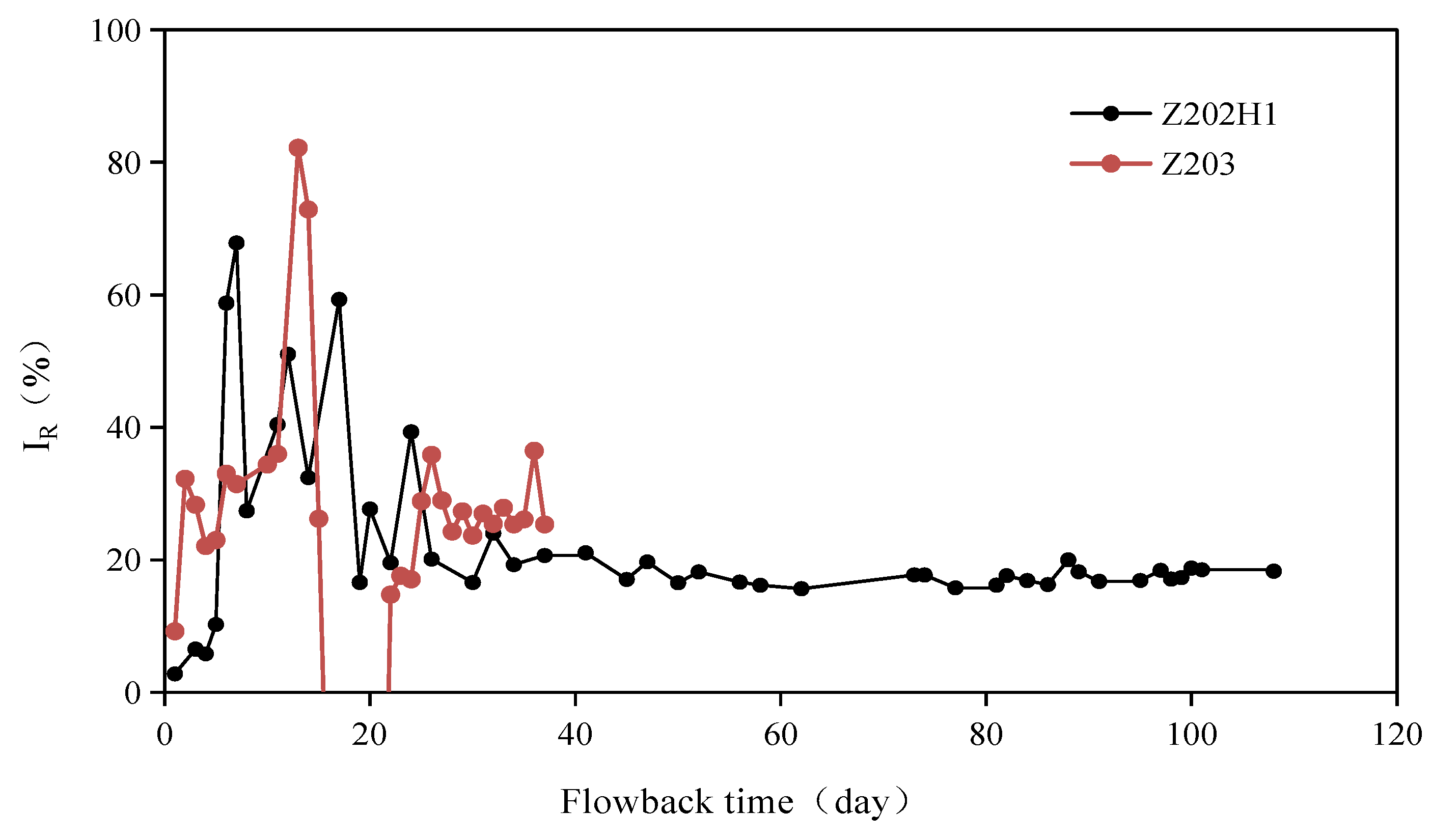The Indicative Role of Geochemical Characteristics of Fracturing Flowback Fluid in Shale Gas Wells on Production Performance
Abstract
:1. Introduction
2. Geological Setting
3. Materials and Experiment
3.1. Sample Collection
3.2. Methodology
3.2.1. Ion Concentration Test
3.2.2. Stable Isotope Ratio Test
4. Results
4.1. FF and Production Water Geochemical Characteristics
4.2. Relationship between Ion Concentration of FFF and Flowback Time
4.3. Relationship between Stable Isotope Ratio of FFF and Flowback Time
5. Discussion
5.1. Source of Ions and Stable Isotope in FFF
5.2. Calculation of FF Content in FFF
5.2.1. Water–Rock Reaction Intensity
5.2.2. Calculation of FF Content
5.3. Relationship between Geochemical Flowback Behavior of FFF and Fracturing Effect
6. Conclusions
Author Contributions
Funding
Data Availability Statement
Conflicts of Interest
References
- Ma, X.; Xie, J. The progress and prospects of shale gas exploration and exploitation in southern Sichuan Basin, NW China. Pet. Explor. Dev. 2018, 45, 161–169. [Google Scholar] [CrossRef]
- Zhang, C.; Zhang, J.; Li, W. Deep shale reservoir characteristics and exploration potential of Wufeng-Longmaxi Formations in Dazu area, western Chongqing. Nat. Gas Geosci. 2019, 30, 1794–1804. [Google Scholar]
- Li, Q.C.; Li, Y.D.; Cheng, Y.F.; Li, Q.; Wang, F.; Wei, J.; Liu, Y.; Zhang, C.; Song, B.; Yan, C.; et al. Numerical simulation of fracture reorientation during hydraulic fracturing in perforated horizontal well in shale reservoirs. Energy Sources 2018, 40, 1807–1813. [Google Scholar] [CrossRef]
- Li, Q.C.; Li, Y.D.; Li, Q. Development and verification of the comprehensive model for physical properties of hydrate sediment. Arab. J. Geosci. 2018, 11, 325. [Google Scholar] [CrossRef]
- Zou, C.N.; Dong, D.Z.; Wang, Y.M.; Li, X.; Huang, J.; Wang, S.; Guan, Q.; Zhang, C.; Wang, H.; Liu, H.; et al. Shale gas in China: Characteristics, challenges and prospects (II). Pet. Explor. Dev. 2016, 43, 166–178. [Google Scholar] [CrossRef]
- Vincent, M. The next opportunity to improve hydraulic-fracture stimulation. J. Pet. Technol. 2012, 64, 118–127. [Google Scholar] [CrossRef]
- Ferrer, I.; Thurman, E.M. Chemical constituents and analytical approaches for hydraulic fracturing waters. Trends Environ. Anal. Chem. 2015, 5, 18–25. [Google Scholar] [CrossRef]
- Han, H.F.; He, Q.Y.; Wang, L. The current situation of flowback technology and its further development research for shale-gas wells in Changning block. Drill. Prod. Technol. 2017, 40, 69–71. [Google Scholar]
- Vidic, R.D.; Brantley, S.L.; Vandenbossche, J.M.; Yoxtheimer, D.; Abad, J.D. Impact of shale gas development on regional water quality. Science 2013, 340, 1235009. [Google Scholar] [CrossRef]
- Ma, L.; Zhang, C.; Liu, D.Q. Preliminary study on the well-soaking adaptability after fracturing in fuling shale gasfield. Spec. Oil Gas Reserv. 2019, 26, 150–154. [Google Scholar]
- Ghanbari, E.; Abbasi, M.A.; Dehghanpour, H.; Bearinger, D. Flowback volumetric and chemical analysis for evaluating load recovery and its impact on early-time production. In Proceedings of the SPE Unconventional Resources Conference, Calgary, AB, Canada, 5–7 November 2013. [Google Scholar]
- Ghanbari, E.; Gehghanpour, H. Impact of rock fabric on water imbibition and salt diffusion in gas shales. Int. J. Coal Geol. 2015, 138, 55–67. [Google Scholar] [CrossRef]
- Fu, Y.H.; Jiang, Y.Q.; Hu, Q.H.; Luo, T.; Li, Y.; Zhian, L.; Wang, Z.; Yin, X. Fracturing flowback fluids from shale gas wells in Western Chongqing: Geochemical analyses and relevance for exploration & development. J. Nat. Gas Sci. Eng. 2021, 88, 103821. [Google Scholar]
- Jia, B.; Xian, C.G.; Tsau, J.S.; Zuo, X.; Jia, W. Status and Outlook of Oil Field Chemistry-Assisted Analysis during the Energy Transition Period. Energy Fuels 2022, 36, 12917–12945. [Google Scholar] [CrossRef]
- Zolfaghari, A.; Dehghanpour, H.; Noel, M.; Bearinger, D. Laboratory and field analysis of flowback water from gas shales. J. Unconv. Oil Gas Resour. 2016, 14, 113–127. [Google Scholar] [CrossRef]
- He, C.; Li, M.; Liu, W.S.; Barbot, E.; Vidic, R.D. Kinetics and equilibrium of barium and strontium sulfate formation in Marcellus shale flowback water. J. Environ. Eng. 2014, 140, 244–248. [Google Scholar] [CrossRef]
- Rosenblum, J.; Nelson, A.W.; Ruyle, B.; Schultz, M.K.; Ryan, J.N.; Linden, K.G. Temporal characterization of flowback and produced water quality from a hydraulically fractured oil and gas well. Sci. Total Environ. 2017, 596, 369–377. [Google Scholar] [CrossRef] [PubMed]
- Kondash, A.J.; Albright, E.; Vengosh, A. Quantity of flowback and produced waters from unconventional oil and gas exploration. Sci. Total Environ. 2017, 574, 314–321. [Google Scholar] [CrossRef]
- Lu, J.; Darvari, R.; Nicot, J.P.; Mickler, P.; Hosseini, S.A. Geochemical impact of injection of Eagle Ford brine on Hosston sandstone formation-Observations of autoclave water-rock interaction experiments. Appl. Geochem. 2017, 84, 26–40. [Google Scholar] [CrossRef]
- Li, Y.M.; Huang, T.M.; Pang, Z.H.; Jin, C. Geochemical processes during hydraulic fracturing: A water-rock interaction experiment and field test study. Geosci. J. 2017, 21, 753–763. [Google Scholar] [CrossRef]
- Vengosh, A.; Jackson, R.B.; Warner, N.; Darrah, T.H.; Kondash, A. A Critical Review of the Risks to Water Resources from Unconventional Shale Gas Development and Hydraulic Fracturing in the United States. Sci. Total Environ. 2014, 48, 8334–8348. [Google Scholar] [CrossRef]
- Liu, W.S.; Liao, S.M.; Xiang, Q. Status quo of fracturing flowback fluids treatment technologies of US shale gas wells and its enlightenment for China. Nat. Gas Ind. 2013, 33, 158–162. [Google Scholar]
- Jia, C.Y.; Jia, A.L.; He, D.B. Key factors influencing shale gas horizontal well production. Nat. Gas Ind. 2017, 37, 80–88. [Google Scholar]
- Jiang, Y.Q.; Fu, Y.H.; Xie, J.; Dong, D.; Zhou, K.; Cheng, X.; Qi, L.; Zhang, H.; Chen, C.; Ma, T.; et al. Development trend of marine shale gas reservoir evaluation and a suitable comprehensive evaluation system. Nat. Gas Ind. 2020, 7, 205–214. [Google Scholar] [CrossRef]
- Zhao, J.H.; Jin, Z.J.; Jin, Z.K. Lithofacics types and sedlimentary cnvironment of shale in Wufeng-Longmaxi Formation, Sichuan Basin. Acta Pet. Sin. 2016, 37, 572–586. [Google Scholar]
- Lu, Y.B.; Ma, Y.Q.; Wang, Y.X. The Sedimentary Response to the Major Geological Events and Lithofacies Characteristics of Wufeng Formation-Longmaxi Formation in the Upper Yangtze Area. Earth Sci. 2017, 42, 1169–1184. [Google Scholar]
- Ma, X.H.; Xie, J.; Yong, R. Geological characteristics and high production control factors of shale gas in Silurian Longmaxi Formation, southern Sichuan Basin, SW China. Pet. Explor. Dev. 2020, 47, 901–915. [Google Scholar] [CrossRef]
- Ma, X.H.; Li, X.Z.; Liang, F.; Wan, Y.; Shi, Q.; Wang, Y.; Zhang, X.; Che, M.; Guo, W. Dominating factors on well productivity and development strategies optimization in Weiyuan shale gas play, Sichuan Basin, SW China. Pet. Explor. Dev. 2020, 47, 555–563. [Google Scholar] [CrossRef]
- Fang, C.H.; Huang, Z.L.; Wang, Q.Z. Cause and significance of the ultra-low water saturation in gas-enriched shale reservoir. Nat. Gas Geosci. 2014, 25, 471–476. [Google Scholar]
- Engle, M.A.; Rowan, E.L. Geochemical evolution of produced waters from hydraulic fracturing of the Marcellus Shale, northern Appalachian Basin: A multivariate compositional data analysis approach. Int. J. Coal Geol. 2014, 126, 45–56. [Google Scholar] [CrossRef]
- Seales, M.; Dilmore, R.; Ertekin, T. Development of a halite dissolution numerical model for hydraulically fractured shale formations (Part I). J. Unconv. Oil Gas Resour. 2016, 15, 66–78. [Google Scholar] [CrossRef]
- Graham, C.M. Experimental hydrogen isotope studies III: Diffusion of hydrogen in hydrous minerals, and stable isotope exchange in metamorphic rocks. Contrib Miner. Pet. 1981, 76, 216–228. [Google Scholar] [CrossRef]
- Graham, C.M.; Viglino, J.A.; Harmon, R.S. Experimental study of hydrogen isotope exchange between aluminous chlorite and water and of hydrogen diffusion in chlorite. Am. Mineral. 1987, 72, 566–579. [Google Scholar]
- Zolfaghari, S.A.; Noel, M.; Dehghanpour, H. Understanding the Origin of Flowback Salts: A Laboratory and Field Study. In Proceedings of the SPE/CSUR Unconventional Resources Conference, Calgary, AB, Canada, 20–22 October 2015. [Google Scholar]
- Rowan, E.L.; Engle, M.A.; Kraemer, T.F.; Schroeder, K.T.; Hammack, R.W.; Doughten, M.W. Geochemical and isotopic evolution of water produced from Middle Devonian Marcellus shale gas wells, Appalachian basin, Pennsylvania. AAPG Bull. 2015, 99, 181–206. [Google Scholar] [CrossRef]
- Zheng, S.H.; Hou, F.G.; Ni, B.L. Hydrogen and oxygen stable isotopes of precipitation in China. Chin. Sci. Bull. 1983, 28, 801. [Google Scholar]
- Neil, M.B.; Rob, W.; David, B. Rapid water-rock interactions evidenced by hydrochemical evolution of flowback fluid during hydraulic stimulation of a deep geothermal borehole in granodiorite: Pohang, Korea. Appl. Geochem. 2019, 111, 104445. [Google Scholar]
- Osselin, F.; Nightingale, B.; Hearn, G.; Kloppmann, W.; Gaucher, E.; Clarkson, C.; Mayer, B. Quantifying the extent of flowback of hydraulic fracturing fluids using chemical and isotopic tracer approaches. Appl. Geochem. 2018, 93, 20–29. [Google Scholar] [CrossRef]
- Gat, J.R. Isotope Hydrology: A Study of the Water Cycle; Imperial College Press: London, UK, 2010; pp. 122–151. [Google Scholar]
- Osselin, F.; Saad, S.; Nightingale, M. Geochemical and sulfate isotopic evolution of flowback and produced waters reveals water-rock interactions following hydraulic fracturing of a tight hydrocarbon reservoir. Sci. Total Environ. 2019, 687, 1389–1400. [Google Scholar] [CrossRef]
- Balashov, V.N.; Engelder, T.; Gu, X.; Fantle, M.S.; Brantley, S.L. A model describing flowback chemistry changes with time after Marcellus Shale hydraulic fracturing. AAPG Bull. 2015, 99, 143–154. [Google Scholar] [CrossRef]
- Engelder, T.; Cathles, L.M.; Bryndzia, L.T. The fate of residual treatment water in gas shale. J. Unconv. Oil Gas Resour. 2014, 7, 33–48. [Google Scholar] [CrossRef]










| Item | δD | δ18O | Na+ | K+ | Ca2+ | Mg2+ | Sr2+ | Ba2+ | HCO3− | Cl− | Total Salinity |
|---|---|---|---|---|---|---|---|---|---|---|---|
| FF | −23.59 | −3.91 | 12.65 | 0.30 | 54.32 | 8.35 | 0.30 | 0.20 | 85.23 | 93.45 | 315.49 |
| PW | −6.89 | 4.57 | 21,036.22 | 653.56 | 689.32 | 101.35 | 658.84 | 1495.54 | 1645.67 | 26,684.95 | 57,698.11 |
Disclaimer/Publisher’s Note: The statements, opinions and data contained in all publications are solely those of the individual author(s) and contributor(s) and not of MDPI and/or the editor(s). MDPI and/or the editor(s) disclaim responsibility for any injury to people or property resulting from any ideas, methods, instructions or products referred to in the content. |
© 2024 by the authors. Licensee MDPI, Basel, Switzerland. This article is an open access article distributed under the terms and conditions of the Creative Commons Attribution (CC BY) license (https://creativecommons.org/licenses/by/4.0/).
Share and Cite
Yin, X.; Fu, X.; Jiang, Y.; Fu, Y.; Zhang, H.; Jiang, L.; Wang, Z.; Li, M. The Indicative Role of Geochemical Characteristics of Fracturing Flowback Fluid in Shale Gas Wells on Production Performance. Processes 2024, 12, 2097. https://doi.org/10.3390/pr12102097
Yin X, Fu X, Jiang Y, Fu Y, Zhang H, Jiang L, Wang Z, Li M. The Indicative Role of Geochemical Characteristics of Fracturing Flowback Fluid in Shale Gas Wells on Production Performance. Processes. 2024; 12(10):2097. https://doi.org/10.3390/pr12102097
Chicago/Turabian StyleYin, Xingping, Xiugen Fu, Yuqiang Jiang, Yonghong Fu, Haijie Zhang, Lin Jiang, Zhanlei Wang, and Miao Li. 2024. "The Indicative Role of Geochemical Characteristics of Fracturing Flowback Fluid in Shale Gas Wells on Production Performance" Processes 12, no. 10: 2097. https://doi.org/10.3390/pr12102097





